List of Contents
Moisture Analyzer Market Size and Forecast 2025 to 2034
The global moisture analyzer market size was estimated at USD 2.02 billion in 2024 and is predicted to increase from USD 2.15 billion in 2025 to approximately USD 3.61 billion by 2034, expanding at a CAGR of 5.98% from 2025 to 2034. The rise in demand across industries, quality control, compliance standard requirements, technological advancements in devices by automation, cost savings, efficiency improvements, awareness of product quality and safety, and expansion of industries are the key market drivers enhancing the market growth.
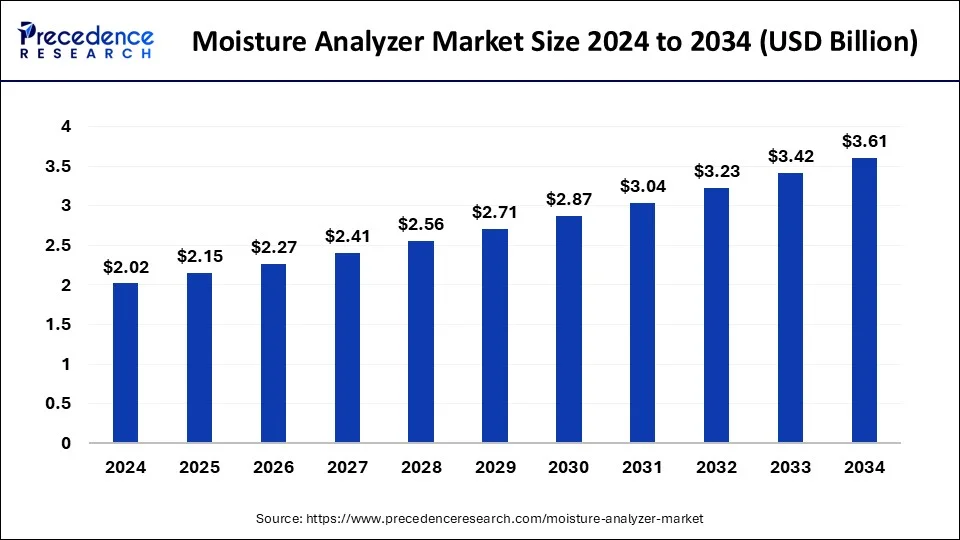
Moisture Analyzer Market Key Takeaways
- The global moisture analyzer market was valued at USD 2.02 billion in 2024.
- It is projected to reach USD 3.61 billion by 2034.
- The moisture analyzer market is expected to grow at a CAGR of 5.98% from 2025 to 2034.
- North America dominated the global market with the largest market share of 40% in 2024.
- Asia Pacific is the fastest-growing region in the global market.
- By equipment, the desktop-mounted segment contributed the highest market share of 49% in 2024.
- By technique, the near-infrared segment is expected to grow at a notable pace during the projected period.
- By application, the food and beverage segment has held the largest market share of 39% in 2024.
Integration of AI in the Moisture Analyzer Market:
The incorporation of artificial intelligence (AI) in the moisture analyzer market is fundamentally transforming the way industries think about moisture measurement and quality control. AI-enabled moisture analyzers allow for predictive analytics, dynamic data analysis and automated calibration while also mitigating human error and improving efficiency. With even the simplest machine learning algorithms, these intelligent systems can recognize trends in the way a particular material responds to moisture quantification in a variety of industries including pharmaceuticals, food processing, agriculture and chemicals.
There are many advantages to AI incorporation including easier cloud connectivity, remote monitoring and IoT functional use. This is so in line with the industry 4.0 movement toward smarter, scalable and cheaper manufacturers are increasingly discovering a potential solution for the moisture measurement and control market in AI driving more precise and faster quantification, the moisture analysis innovation/driving growth is a critical component of the global growth dynamic for everybody.
Government Initiatives taken in Moisture Analyzer Market:
Government initiatives and rising product quality and food safety awareness are substantially driving the growth of the Moisture Analyzer Market. Agencies such as the FDA in the U.S., FSSAI in India, and the European Food Safety Authority (EFSA) enforce standards that require strict compliance with moisture content testing across many industries, including food processing, pharmaceuticals, agriculture, and chemicals. Initiatives such as “Make in India” and China's Quality Infrastructure Development Plan support domestic manufacturing and new and emerging technologies for analytical equipment, including moisture analyzers.
The governance structure also encourages companies to use moisture analyzers under environmental governance provisions, such as the REACH directive, to eliminate waste in production and the European Energy Efficiency Directive, to conserve energy.
Further, the government offers R&D funding and tax incentives for companies developing AI integrated, smart, portable moisture analyzers, in parallel to the global transition to precision, automation, and sustainability associated with quality control practices and process improvements.
U.S. Moisture Analyzer Market Size and Growth 2025 to 2034
The U.S. moisture analyzer market size was estimated at USD 565.6 million in 2024 and is projected to surpass around USD 1,030.75 million by 2034 at a CAGR of 6.10% from 2025 to 2034.
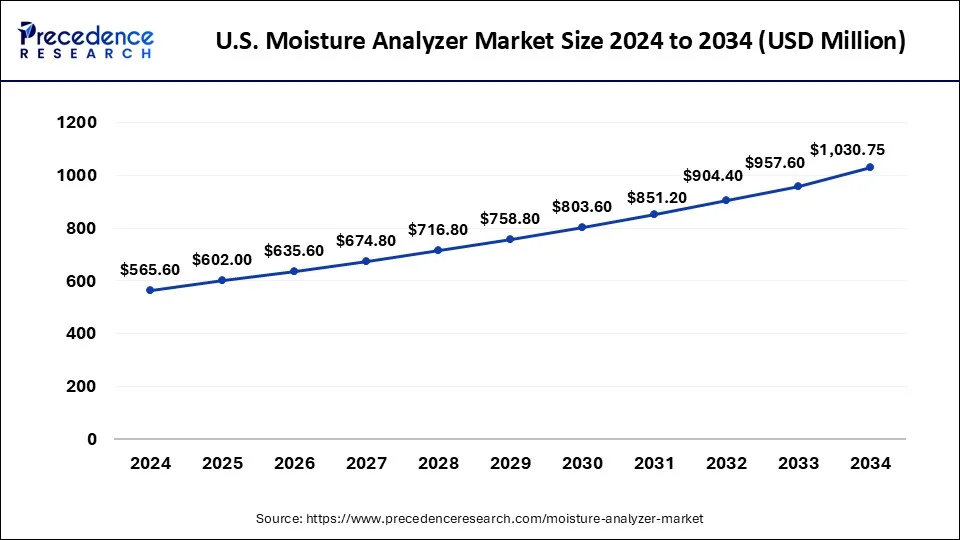
Considering North America, the U.S. was estimated to be the largest contributor to the moisture analyzer market in 2024. The presence of competitive manufacturers in the U.S. is responsible for uplifting market growth. Consumers' requirements for qualitative food products, beverages, and other essential goods have forced producers to maintain the quality of all their products, thus resulting in the expansion of the moisture analyzer market.
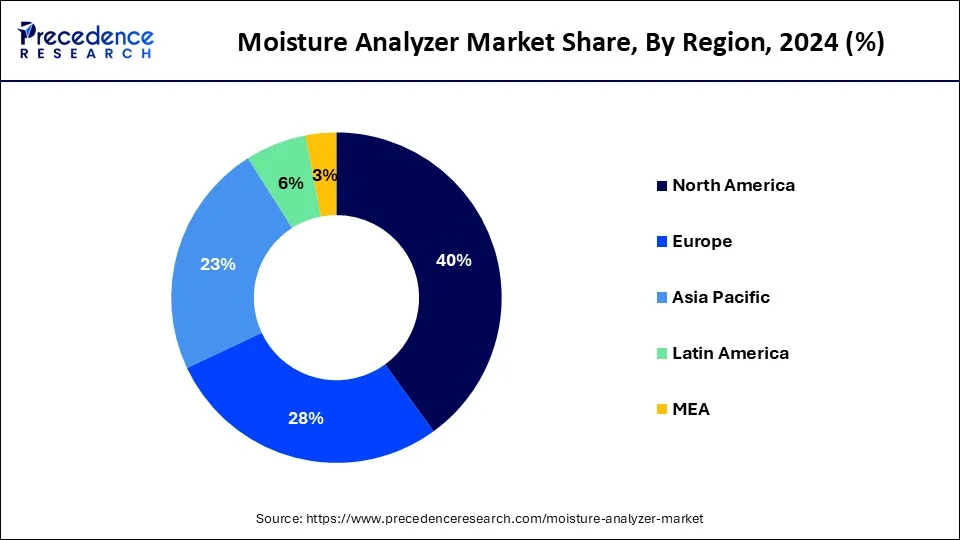
Asia Pacific is the fastest-growing region in the global moisture analyzer market. The continuous increase in the number of people in Asia Pacific is also responsible for growth. Growth in population and urbanization increase the market demand for a wide variety of goods and services. Moreover, countries like China and India are the main reasons behind the expansion of the moisture analyzer market in the region. Also, Rapid developments in the chemical and pharmaceutical companies and significant growth in the food and beverages industries are creating a high demand for moisture analyzers.
North America:
The regions abundance of large-scale and technically advanced industry infrastructure and strict regulatory standards makes it a viable market for moisture analyzers. The pharmaceutical, chemical, food and beverages and environmental testing industries generate major demand for high-accuracy moisture testing and monitoring to meet FDA, EPA and ISO standards. Notably, the region's growth is expected to accelerate over the next several years due to the growing presence of regional firms and suppliers of AI-powered and fully automated analyzers.
Furthermore, increases in quality assurance initiatives, smart lab adoption and real-time moisture testing and tracking are all believed to fuel growth in many North American locations including organization the U.S. and Canada. North American investments in research, biotechnology and sustainable manufacturing are accelerating innovation in moisture testing technology and will continue to play significant role in market growth, serving as a key growth and innovation hub in the international context.
Asia-Pacific:
The Asia-Pacific moisture analyzer market is growing at a rate faster as it is driven by rapid industrialization, increasing manufacturing footprints and the need for quality control and regulatory compliance. China, India, Japan, and South Korea are key contributors with some users in pharmaceuticals, food & beverages, chemicals, and agricultural industries. With the demand for accurate moisture detection in both raw material and finished goods, users are adopting technological advancements to optimize their manufacturing processes, thus utilizing more infrared, halogen, and similarly based technologies.
Government initiatives supporting industrial automation together with emerging, stricter food safety laws are rapidly driving the adoption of moisture analyzers. The Asia-Pacific is also seeing increased investments in R&D, biotechnology, and smart manufacturing, which is creating significant growth opportunities for manufacturers and suppliers of smart moisture analysis products that integrate AI technologies as new ways to differentiate their products.
Europe:
Europe represents a large share of the global moisture analyzer market, largely due to a good industrial presence and strict regulatory languages surrounding the pharmaceutical, food & beverage, chemical, and environmental science sectors. Germany, France, the UK, and Italy are attaining a high level of adoption of halogen, infrared, and AI-based analyzers to meet EU quality and safety regulations. Europe places a lot of emphasis on sustainability, precision manufacturing and quality assurance, which leads to increased investments into laboratory automation and testing methodologies.
Additionally, increased R&D investment in biotechnology and a growing understanding of product consistency and reducing waste are leading to greater demand for high-performing analyzers. Going forward, with growing investment and growth at a moderate level with technology developed and regulatory support, Europe grows to become a technological progressive country, and continuing to push compliance forward on quality, heavily influencing the future growth of the relative global moisture analyzer market.
Latin America:
Latin America is emerging as a strong region in the global moisture analyzer market as it continues to undergo gradual industrialization, growing manufacturing sites, and increasing focus on quality control and food safety standards. Some of the leader latam countries that are witnessing increasing implementations of moisture analysis technologies are Brazil and Mexico with increasing consumption in food & beverage, agriculture, pharmaceutical and chemical industries.
As Latin America is usually export-oriented, many local manufacturers have embraced halogen and infrared moisture analyzers to comply with international regulations and improve product quality. In parallel, the increasing focus on moisture management for optimizing shelf-life, efficiency, waste reduction is supporting the inertia of market growth. Several government policies promoting industrial modernization and automation, as well as companies examining their processes for sustainable production, are also expanding the potential in the region's market.
What are the Major Trends in Moisture Analyzer Market
- Elevating Quality Control (QC) Industry Standards: Industries like food & beverage, pharmaceuticals, and chemicals are using moisture analyzers to meet stringent quality and safety standards.
- Technology Advancements: Newer moisture analyzers (like halogen-based and infrared analyzers) are going to provide faster and more accurate results, enhancing efficiency in laboratory and production facilities.
- Increased Automation of Manufacturing: Using automated testing and digital moisture analysis will improve throughput and decrease human error.
- Rising Demand from Emerging Economies: Emerging economies in Asia-Pacific, Latin America and the Middle East are developing rapidly, which is improving the level of precision-testing equipment adoption.
- Sustainability and Waste Reduction: Accurate moisture analysis helps reduce waste and align with trends toward sustainability, enriching market growth.
- Broadening Range of Applications: Moisture analyzers' flexibility and excellent applicability across multiple sectors (agriculture, textiles, plastics, and construction) will enable them to further penetrate the existing market and supports sustained demand in the future.
Market Overview
Moisture analyzers, also sometimes known as moisture balances, are used to measure the moisture content of different types of samples, such as solids, liquids, and gases. The determination of trace moisture in solids is necessary for plastics, pharmaceuticals, and heat treatment processes. Moisture analyzers help determine the moisture content of different products based on the loss on dying method (LOD), in which the sample is heated to evaporate the moisture content and finally record the weight loss caused by evaporation.
Moisture is one of the most important factors for maintaining the texture, appearance, taste, and shelf life of different products. Accurate moisture content plays an essential role in maintaining the quality of products, mainly in the pharma, food, research, and chemical industries. Moisture analyzers are used in different industries for many purposes. In the food industry, it plays a vital role in controlling humidity as excess moisture in food products can cause spoilage of food and is not further safe for human consumption purposes. Too little moisture in food products can cause the drying of food items and reduce the calories present in them.
Moisture analyzers are also used to determine the quantity of water present in oil, fuel, and many other chemicals. Many key players present in the market are focusing more on the launching of innovative machines for measuring the moisture content of different samples. Hence, it increases the demand for moisture analyzers and drives the growth of the moisture analyzer market.
The moisture analyzer market is currently experiencing a strong uptick because of heightened demand from several industries, including pharmaceuticals, food & beverages, plastics, and chemicals. Moisture analyzers are important in terms of quality control, and production efficiency as they provide moisture measurements for raw materials and final products.
With increasingly stringent regulatory standards (healthcare, food safety) on a global scale, critical moisture analysis requirements are even more prevalent. The addition of new technologies (halogen, IR, and microwave-based analyzers) has improved speed, accuracy, and ease of use, along with aspects of automation and digitalization making the devices much more accessible for the lab and industrial sector.
Moisture Analyzer Market Growth Factors
- Consumer demand for the safety and quality of different products manufactured in industries increases the market's growth and forces manufacturers to maintain the quality of their goods before introducing them to the market.
- Food and beverages, pharmaceuticals, semiconductors, polymers, and other industries require regular monitoring devices to observe different parameters, including moisture, which propels the market's growth.
- Raw materials are required for producing final products, and maintaining their moisture content is essential because moisture fluctuates the functioning of different materials.
- Different drugs manufactured in pharmaceutical industries have different chemical compositions and molecules. They are very sensitive to moisture variations, so pharmaceutical companies need high accuracy in terms of moisture content while developing drugs.
Market Scope
| Report Coverage | Details |
| Market Size in 2024 | USD 2.02 Billion |
| Market Size in 2025 | USD 2.15 Billion |
| Market Size by 2034 | USD 3.61 Billion |
| Market Growth Rate from 2025 to 2034 | CAGR of 5.98% |
| Base Year | 2024 |
| Forecast Period | 2025 to 2034 |
| Segments Covered | By Equipment Type, By Technique, and By Applications |
| Regions Covered | North America, Europe, Asia-Pacific, Latin America, and Middle East & Africa |
Market Dynamics
Drivers
Increased attention in consumers towards the quality of different products
Quality control standards primarily drive the moisture analyzers market in a large number of industries. Due to increased globalization and consumer expectations for reliable, safe, and quality products, manufacturers are concerned regarding the safety of goods. They are involved in offering products with good quality standards. Many companies are trying to make significant investments in quality control procedures to monitor and evaluate the level of production of their products. They are further promoting the growth in the moisture analyzer market.
To accomplish the goals of various industries, moisture analyzer devices are very helpful and fulfill the demands of consumers. Also, many industries are launching innovative devices to monitor the moisture content of products. Novel innovative machines have been launched that use advanced versions to monitor moisture content more accurately and efficiently. They enable improved quality control and optimization of manufacturing processes in various industries such as pharmaceutical, agricultural, and research organizations.
Increased demand for food and beverage products
The rising demand for food and beverage products among people worldwide is driving the growth of the moisture analyzer market. Moisture analyzers play an essential role in the food and beverage sectors as food and beverages require a proper quality standard before being delivered to various consumers. Food is one of the products that can be degraded very fast due to moisture level fluctuation. Too much high or low moisture content in food products can cause deterioration or spoilage of food items, loss of calories, and drying of food.
Restraint
High cost of moisture analyzers
The high expense associated with moisture analyzers is the main factor hampering the growth of the moisture analyzer market. These increasing high costs are more of a concern for small-scale and medium-scale manufacturers because their profitable income is low compared to that of large manufacturers of various industries. Advancements launched on various moisture-determining devices require more budget as the parts, such as heating elements and others, are much more expensive. All these reasons decrease the interest in moisture analyzers and degrade the growth of the moisture analyzer market.
Opportunity
Innovations and advancements in moisture analyzers
The increase in the preference for advanced and innovative moisture analyzers in various industries is a crucial step for accelerating market growth and raising regular advancements in technology. Industrial and process automation refers to the application of intelligence technology in industrial processes instead of performing it manually. Manual processes require repetitive tasks and more labor to perform. Automated moisture analyzers are fast, accurate, and intuitive, which helps to increase automation processes and reduce the need for labor. The increased demand and adoption of automation in various industrial processes during manufacturing, quality checks, and transportation drive the moisture analyzer market.
Equipment Type Insights
The desktop-mounted segment dominated the moisture analyzer market in 2024.Desktop-mounted devices are more comfortable to use for detecting the moisture content in a sample. People started demanding and raising awareness about using desktop analyzing devices for moisture-detecting purposes. Hence, this is driving the growth of the moisture analyzer market.
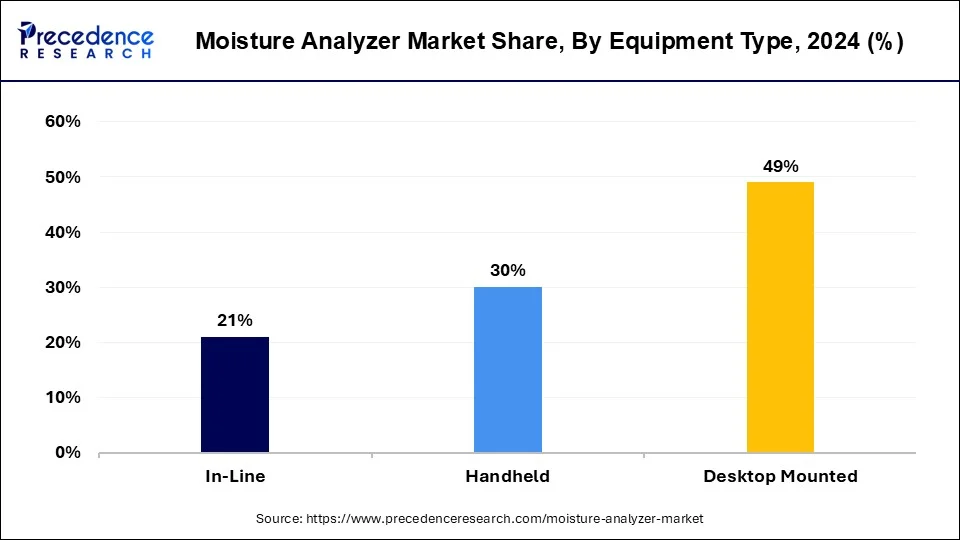
Moisture Analyzer Market Revenue, byEquipment Type (USD Million)
| Equipment Type | 2022 | 2023 | 2024 |
| In-Line | 814.60 | 853.1 | 898.8 |
| Handheld | 530.8 | 557.9 | 589.9 |
| In-line | 386.7 | 408.1 | 433.3 |
Technique Insights
The moisture analyzer market, the near-infrared segment is expected to grow at a notable pace during the projected period of 2025-2034. The near-infrared technique is more advantageous than others and is used regularly to monitor moisture content in various industrial products. Nowadays, near-infrared technology is widely used in the food processing, pharmaceuticals, packaging, chemical, and textile industries.
Moisture Analyzer Market Revenue, by Technique (USD Million)
| Technique | 2022 | 2023 | 2024 |
| Karl Fischer Titration | 475.4 | 501.4 | 531.9 |
| Loss on drying (LoD) | 532.2 | 557.4 | 587.1 |
| Capacitance | 239.8 | 250.6 | 263.5 |
| Near-Infrared | 350.2 | 370.4 | 394.0 |
| Others | 134.4 | 139.4 | 145.5 |
Application Insights
The food & beverage segment dominated the moisture analyzer market in 2024and is expected to continue its dominance over the forecast period. Food and beverage products require moisture monitoring because the chances of food and beverage products' spoilage are very high due to the presence of humidity. Moisture analyzer devices are essential for regularly checking the presence of moisture.
Moisture Analyzer Market Revenue, by Appplication (USD Million)
| Appplication | 2022 | 2023 | 2024 |
| Food & Beverage | 468.9 | 490.8 | 516.7 |
| Pharmaceuticals | 418.0 | 441.6 | 469.3 |
| Chemical and Petroleum | 299.5 | 315.7 | 469.3 |
| Research & Academics | 188.2 | 197.3 | 208.1 |
| Metal & Mining | 116.1 | 122.2 | 129.4 |
| Semiconductor | 92.3 | 96.8 | 102.1 |
| Plastic & Polymer | 65.6 | 68.5 | 72.0 |
| Others | 83.5 | 86.2 | 89.6 |
Accurate moisture in food and beverage products helps to maintain the texture, appearance, taste, and weight of different products. Also, strict government regulations are imposed on the food and beverage industries to maintain the quality, safety, and appropriate moisture content of edible products. Hence, the food and beverage segment propels the growth and expansion of the moisture analyzer market.
Moisture Analyzer Market Companies
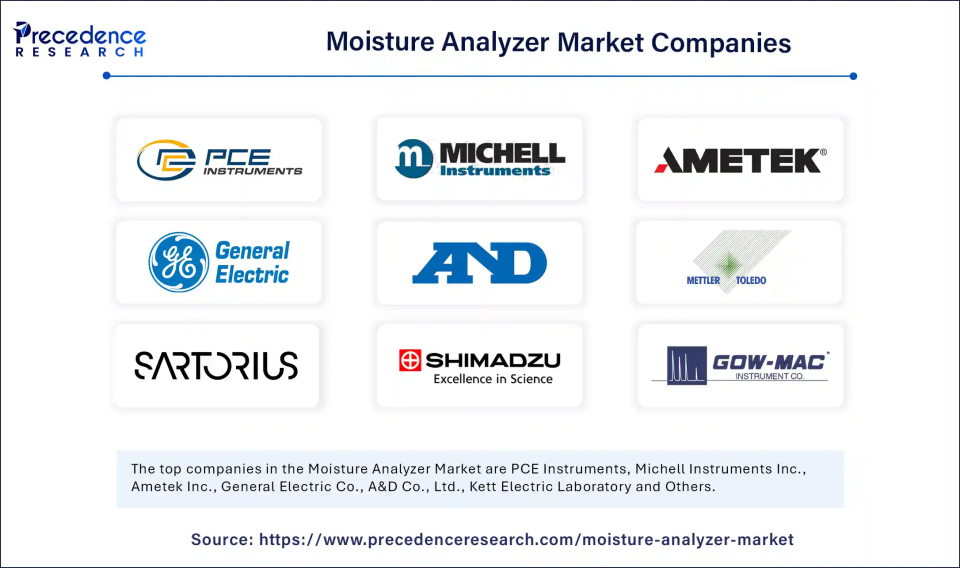
- PCE Instruments
- Michell Instruments Inc.
- Ametek Inc.
- SpectraSesnsors Inc.
- General Electric Co.
- A&D Co., Ltd.
- Kett Electric Laboratory
- Mettler-Toledo International Inc.
- Sartorius AG
- Shimadzu Corp.
- Gow-Mac Instrument Co.
- Mitsubishi Chemical Holdings Corp.
- Sinar Technology
- Thermo Fisher Scientific Inc.
- U-Therm International (H.K.) Ltd.
- Adam Equipment Ltd
- AMETEK Brookfield
- Metrohm India Limited
- Brookhuis Applied Data Intelligence
Recent Developments
- In March 2024, Alliance Scale, a well-known distributor company, introduced a moisture analyzer that provides a single-step operation to perform quality control of all types of grains, foods, fish, meat, nuts, and seafood more accurately and precisely. This analyzer uses a halogen heating element to dry the moisture content in products.
- In June 2023, CEM Corporation, a leading provider of innovative testing solutions, announced the launching of the novel Quartz Halogen Moisture Analyzer. It is the most popular and fastest-working infrared moisture analyzer and has been declared to have outstanding performance in Pharmaceuticals, Plastics, Dairy Powders, Processed Foods, and many other industries.
- In March 2023, Novatec announced an exclusive partnership with Aboni company in Germany. Novatec helps in distributing offline moisture analyzers, namely HT3 Hydrotracer of Aboni, in North and Latin America. This device detects the accurate amount of moisture content present mainly in solids through calcium hydride.
Segments Covered in the Report
By Equipment Type
- Desktop Mounted
- Handheld
- In-line
By Technique
- Karl Fischer Titration
- Loss on Drying
- Capacitance
- Near-infrared
- Others
By Applications
- Food and Beverage
- Pharmaceuticals
- Chemical & Petroleum
- Research & Academics
- Metal & Mining
- Semiconductor
- Plastic & Polymer
- Others
By Geography
- North America
- Europe
- Asia-Pacific
- Latin America
- Middle East and Africa
For inquiries regarding discounts, bulk purchases, or customization requests, please contact us at sales@precedenceresearch.com
Frequently Asked Questions
Ask For Sample
No cookie-cutter, only authentic analysis – take the 1st step to become a Precedence Research client